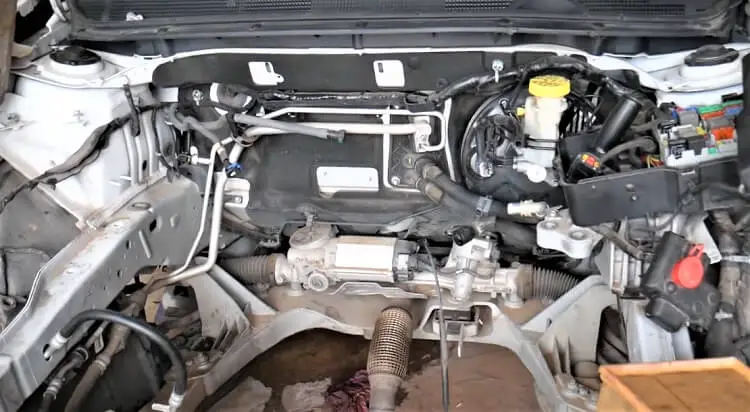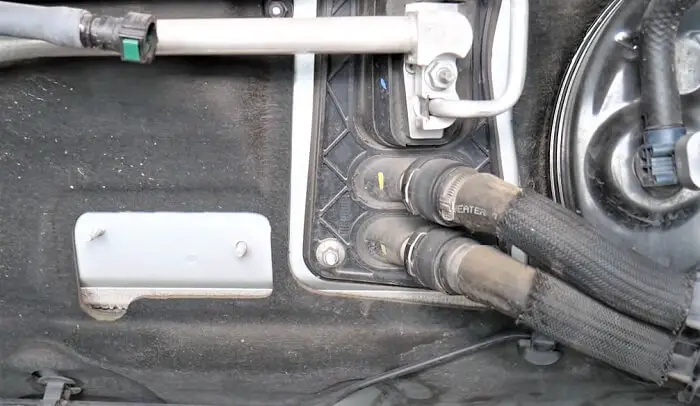| Note: This article may contain affiliate links, which means if you make a purchase following our links won’t cost you extra, but we may earn a commission. Learn more |
If your car’s heater isn’t working, the problem could be a bad heater core. The heater core is a small radiator-like device that contains hot engine coolant and blows warm air into the car’s cabin.
If the heater core is damaged or clogged, it won’t be able to do its job properly. As a result, your car’s cabin won’t be as warm as it should be. In some cases, a bad heater core can also cause your car’s windows to fog up.
If you think your car’s heater core might be going bad, it’s important to have it checked out by a mechanic as soon as possible. Otherwise, you could end up with a much more serious problem on your hands.

What Causes a Heater Core to Go Bad?
A heater core is a small radiator-like device used in forced air heating systems to heat the cabin of a vehicle. The heater core is usually located under the dashboard on the passenger side of the vehicle. Hot engine coolant is passed through the heater core tubes to heat the air being blown into the cabin by the blower motor. A heater core that is not working properly can be the result of a coolant leak, a blown fuse, or a clogged air filter.
Coolant Leak
One of the most common reasons for a heater core to go bad is a coolant leak. Coolant leaks can occur in the engine, radiator, hoses, or heater core. If the leak is in the engine, it will need to be fixed as soon as possible to avoid engine damage.
A radiator leak can be fixed by replacing the radiator or patching the leak. A leak in a hose can be fixed by replacing the hose or using a hose clamp to tighten it. If the leak is in the heater core, the core will need to be replaced.
Blown Fuse
Another common reason for a heater core to go bad is a blown fuse. The fuse that controls the heater core is usually located in the fuse box under the hood. If the fuse is blown, it will need to be replaced.
Clogged Air Filter
A clogged air filter can also cause a heater core to go bad. The air filter is located in the air intake duct on the side of the vehicle. If the air filter is clogged, it will need to be replaced.
Can You Drive With a Bad Heater Core?
A bad heater core can prevent your car’s heater from working properly. If you notice that your car’s heater is not blowing hot air, or if the air smells sweet or antifreeze-like, then it’s likely that your heater core is leaking. You should take your car to a mechanic to have it checked out as soon as possible.
Driving with a bad heater core is not advisable, as it can lead to further damage to your car and may even cause engine overheating.
How Often Do Heater Cores Fail?
Heater cores are one of those car parts that you hope never fail, but unfortunately, they sometimes do. If your heater core starts leaking, you’ll likely notice a sweet smell in the cabin of your car and steam on the windows. So how often do heater cores fail?
There’s no definitive answer, as it can vary depending on the make and model of your car, as well as how well you take care of it. But generally speaking, heater cores tend to last around 10 years or so. Of course, if you’re regularly using your heater and/or live in a cold climate, your heater core may not last quite as long.
If your heater core does start to leak, it’s important to get it fixed as soon as possible. A leaking heater core can cause all sorts of problems, including damaging your car’s electronics and causing mold to grow inside the cabin. So if you think your heater core might be leaking, don’t hesitate to take it to a mechanic for inspection.
Related Post: Will Heater Core Leak If Heat is off?
How Can You Tell If Your Heater Core is Bad?
When it comes to your car, the heater core is one of those parts that you don’t really think about – until it goes bad. Then, it becomes a big problem. So, how can you tell if your heater core is bad? Here are some signs to look for:
1. Your Car is Leaking Antifreeze
If you notice a sweet-smelling, bright green liquid leaking from your car, it is probably antifreeze. And, if it is coming from near the dashboard on the passenger side, it is likely coming from a bad heater core.
2. Your Car’s Windows Are Fogging Up
Another sign of a bad heater core is if your car’s windows start to fog up, even when it isn’t raining or snowing outside. This is because the antifreeze that is leaking from the heater core is getting into the car’s ventilation system and then recirculating through the cabin.
3. You Are Losing Coolant
A bad heater core can also cause your car to lose coolant. So, if you notice that you are having to add coolant more often than usual, it could be a sign that your heater core is leaking.
4. Your Car is Overheating
If your car starts to overheat, even when you haven’t been driving it for very long, it could be a sign of a bad heater core. This is because the leaking coolant is causing your car to lose its ability to properly cool itself down.
5. You See Steam Coming From Under the Hood
Another sign that your heater core is leaking is if you see steam coming from under the hood of your car. This is because the leaking coolant is getting onto hot engine parts and causing them to steam.
If you notice any of these signs, it is important to take your car to a mechanic to have it checked out. A bad heater core can cause a lot of damage to your car if it is left unchecked.

How Long Should a Heater Core Last?
A heater core is a small radiator-like device that is used to heat up the cabin of a vehicle. The heater core is located in the dash and is connected to the engine’s cooling system. The hot coolant from the engine passes through the heater core and warms up the air that is blown into the cabin by the blower motor.
The lifespan of a heater core varies depending on the make and model of the vehicle, as well as how often it is used. In general, however, a heater core should last for several years without any problems. If your vehicle’s heater core starts to leak or otherwise fails, it will need to be replaced.
Bad Heater Core Symptoms-10 Tell Tail Signs That You Have a Heater Core Problem
How to Tell If Heater Core is Clogged?
If you notice your car is taking longer to heat up, or the defrost isn’t working as well as it used to, there’s a good chance your heater core is clogged. A clogged heater core will eventually prevent your car from heating up at all. Here are a few other signs that indicate a clogged heater core:
-Your car smells sweet or like antifreeze-There’s steam coming from under the hood-The temperature gauge needle fluctuates wildly
If you suspect your heater core is clogged, the best thing to do is take it to a mechanic and have them check it out. They’ll be able to tell for sure and can flush the system if necessary.
Side Effects of Bypassing Heater Core
Bypassing your heater core may seem like a good way to save money, but it can actually have some pretty serious consequences. For starters, it can cause your engine to overheat. Additionally, it can lead to poor engine performance and decreased fuel economy.
And if that wasn’t enough, bypassing your heater core can also result in a buildup of harmful chemicals in your engine coolant system. So, while it may be tempting to bypass your heater core in an attempt to save money, it’s really not worth the risk.
How to Test a Heater Core?
When it comes to your car, the heater core is one of those things you don’t really think about until it goes wrong. But if your heater core starts leaking, it can cause all sorts of problems. Not only will your car’s interior get soaked, but the leak can also damage other parts of the car.
So how do you know if your heater core is leaking? And what can you do to fix it? Here’s everything you need to know about testing and repairing a leaking heater core.
What is a Heater Core?Before we get into how to test for a leak, let’s first take a look at what a heater core is and what it does. The heater core is located under the dash and looks like a small radiator.
It’s filled with hot coolant from the engine, and as that coolant circulates through the core, it heats up the air that gets blown into the cabin by the blower motor.How to Test for a LeakThere are a few different ways to test for a leak in your heater core.
One way is to simply keep an eye on your coolant level. If you notice that it’s dropping quickly or there’s coolant pooled up under your car, then there’s likely a leak in the system somewhere. Another way to tell if there’s a problem is by looking for signs of coolant inside the car itself – either on the floor mats or on other surfaces near where the vents blow out hot air.
Finally, if your car starts overheating frequently or runs out of heat entirely, that could be another sign that there’s something wrong with the heater core.
Can a Clogged Heater Core Cause Overheating?
If your car is overheating, it could be due to a clogged heater core. The heater core is part of the car’s cooling system and helps to heat the cabin of the car. If the heater core becomes clogged, it can cause the engine to overheat.
There are a few signs that you may have a clogged heater core, such as:
-The cabin of your car is not getting warm enough
-You notice steam coming from under the hood of your car
-Your engine starts to overheat If you suspect that your heater core may be clogged, it’s important to take care of it right away. A clogged heater core can cause serious damage to your engine if left untreated.
To clean out your heater core, you’ll need to flush it with a solution of water and vinegar. You can do this by disconnecting the hoses that lead to the heater core and running water through them until they run clear. Then, fill up the system with a 50/50 mixture of water and vinegar and let it run for a few minutes before flushing it out again with just water.
Conclusion
A heater core going bad is often caused by a build-up of mineral deposits, which can restrict or block the flow of coolant. This can happen if the coolant isn’t changed often enough, or if the water used contains a lot of minerals. Another potential cause is a leak in the cooling system, which can allow air to get into the system and cause corrosion.
Featured image credit: www.youtube.com
Read More:
